The 11 Greatest Vacuum Tubes You’ve Never Heard Of
These vacuum devices stood guard during the Cold War, advanced particle physics, treated cancer patients, and made the Beatles sound good
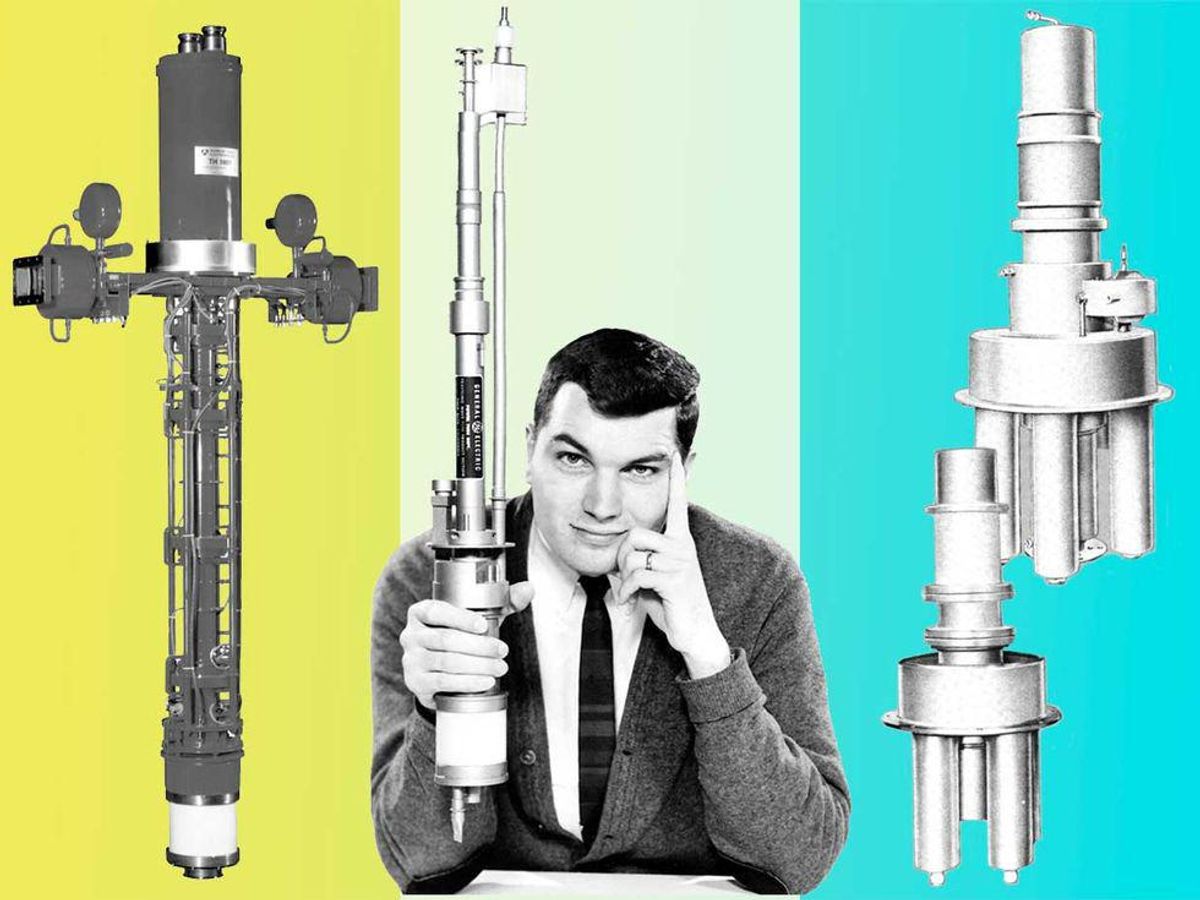
In an age propped up by quintillions of solid-state devices, should you even care about vacuum tubes? You definitely should! For richness, drama, and sheer brilliance, few technological timelines can match the 116-year (and counting) history of the vacuum tube. To prove it, I've assembled a list of vacuum devices that over the past 60 or 70 years inarguably changed the world.
And just for good measure, you'll also find here a few tubes that are too unique, cool, or weird to languish in obscurity.
Of course, anytime anyone offers up a list of anything—the comfiest trail-running shoes, the most authentic Italian restaurants in Cleveland, movies that are better than the book they're based on—someone else is bound to weigh in and either object or amplify. So, to state the obvious: This is my list of vacuum tubes. But I'd love to read yours. Feel free to add it in the comments section at the end of this article.
My list isn't meant to be comprehensive. Here you'll find no gas-filled glassware like Nixie tubes or thyratrons, no “uber high" pulsed-power microwave devices, no cathode-ray display tubes. I intentionally left out well-known tubes, such as satellite traveling-wave tubes and microwave-oven magnetrons. And I've pretty much stuck with radio-frequency tubes, so I'm ignoring the vast panoply of audio-frequency tubes—with one notable exception.
But even within the parameters I've chosen, there are so many amazing devices that it was rather hard to pick just eleven of them. So here's my take, in no particular order, on some tubes that made a difference.
Medical Magnetron
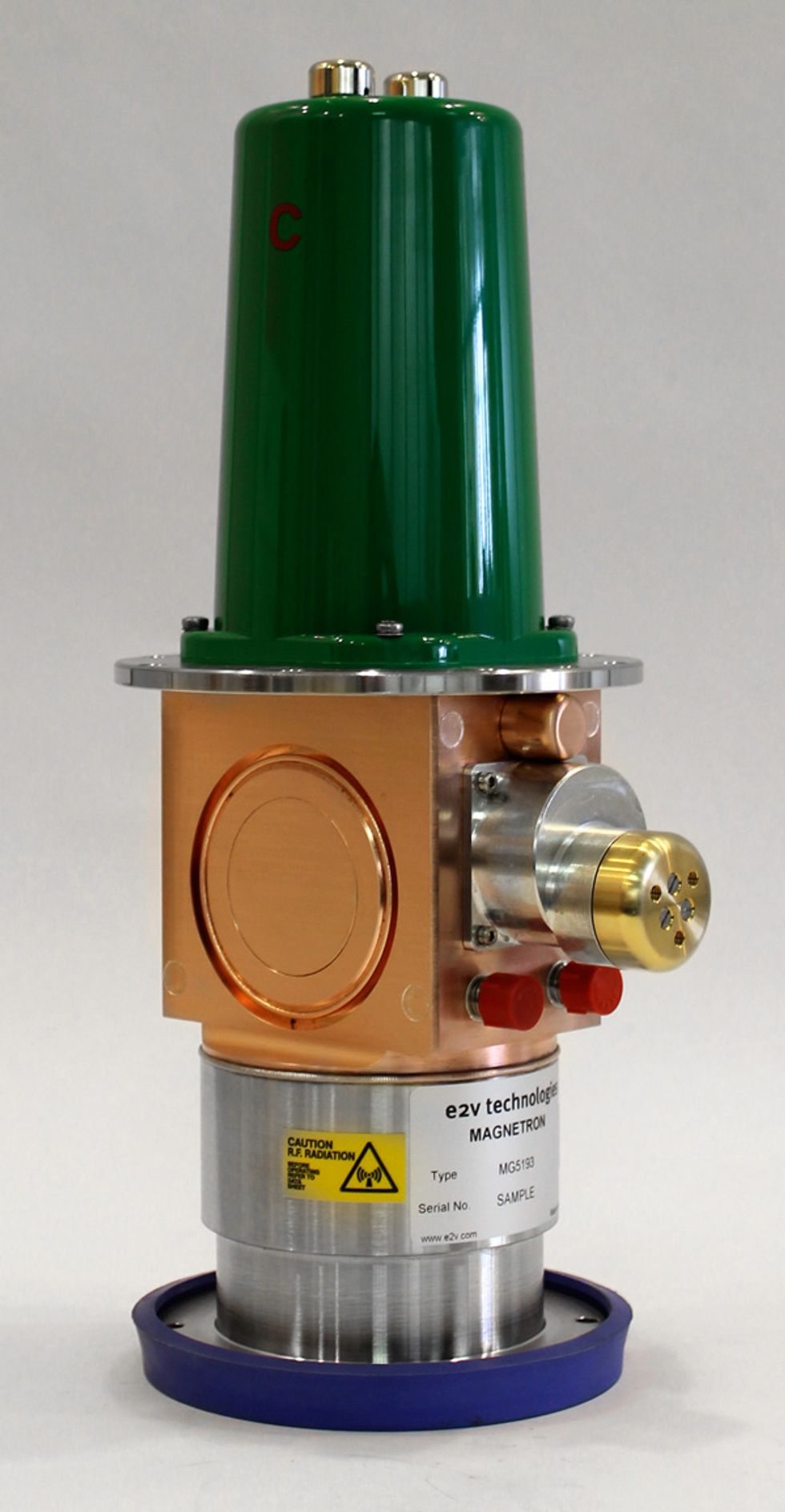
When it comes to efficiently generating coherent radio-frequency power in a compact package, you can't beat the magnetron.
The magnetron first rose to glory in World War II, to power British radar. While the magnetron's use in radar began to wane in the 1970s, the tube found new life in industrial, scientific, and medical applications, which continues today.
It is for this last use that the medical magnetron shines. In a linear accelerator, it creates a high-energy electron beam. When electrons in the beam are deflected by the nuclei in a target—consisting of a material having a high atomic number, such as tungsten—copious X-rays are produced, which can then be directed to kill cancer cells in tumors. The first clinical accelerator for radiotherapy was installed at London's Hammersmith Hospital in 1952. A 2-megawatt magnetron powered the 3-meter-long accelerator.
High-power magnetrons continue to be developed to meet the demands of radiation oncology. The medical magnetron shown here, manufactured by e2v Technologies (now Teledyne e2v), generates a peak power of 2.6 MW, with an average power of 3 kilowatts and an efficiency of more than 50 percent. Just 37 centimeters long and weighing about 8 kilograms, it's small and light enough to fit the rotating arm of a radiotherapy machine.
Gyrotron
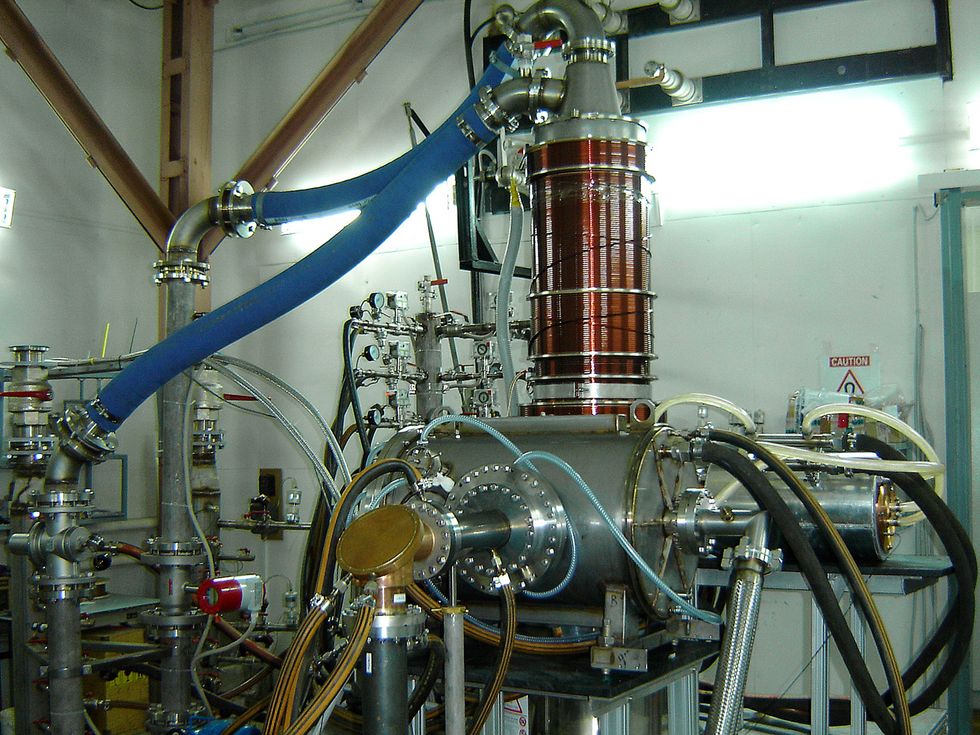
Conceived in the 1960s in the Soviet Union, the gyrotron is a high-power vacuum device used primarily for heating plasmas in nuclear-fusion experiments, such as ITER, now under construction in southern France. These experimental reactors can require temperatures of up to 150 million °C.
So how does a megawatt-class gyrotron work? The name provides a clue: It uses beams of energetic electrons rotating or gyrating in a strong magnetic field inside a cavity. (We tube folks love our -trons and -trodes.) The interaction between the gyrating electrons and the cavity's electromagnetic field generates high-frequency radio waves, which are directed into the plasma. The high-frequency waves accelerate the electrons within the plasma, heating the plasma in the process.
A tube that produces 1 MW of average power is not going to be small. Fusion gyrotrons typically stand around 2 to 2.5 meters tall and weigh around a metric ton, including a 6- or 7-tesla superconducting magnet.
In addition to heating fusion plasmas, gyrotrons are used in material processing and nuclear magnetic resonance spectroscopy. They have also been explored for nonlethal crowd control, in the U.S. military's Active Denial System. This system projects a relatively wide millimeter-wave beam, perhaps a meter and a half in diameter. The beam is designed to heat the surface of a person's skin, creating a burning sensation but without penetrating into or damaging the tissue below.
Mini Traveling-Wave Tube
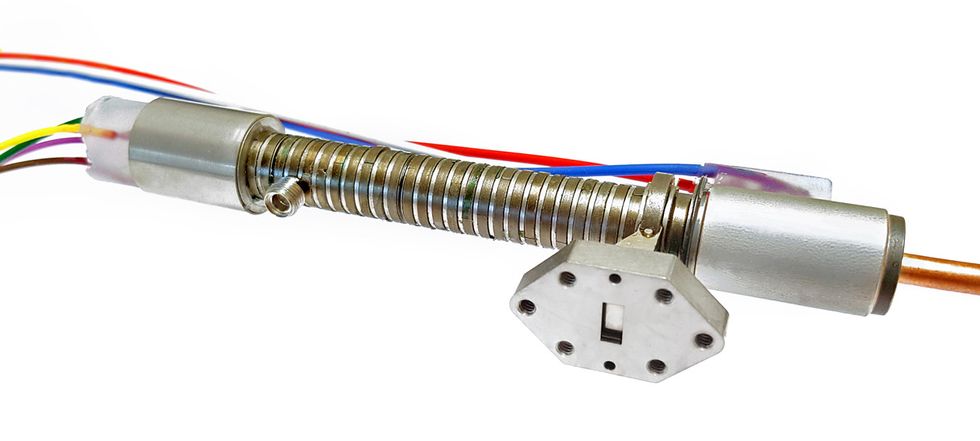
As its name suggests, a traveling-wave tube (TWT) amplifies signals through the interaction between an electric field of a traveling, or propagating, electromagnetic wave in a circuit and a streaming electron beam. [For a more detailed description of how a TWT works, see "The Quest for the Ultimate Vacuum Tube," IEEE Spectrum, December 2015.]
Most TWTs of the 20th century were designed for extremely high power gain, with amplification ratios of 100,000 or more. But you don't always need that much gain. Enter the mini TWT, shown here in an example from L3Harris Electron Devices. With a gain of around 1,000 (or 30 decibels), a mini TWT is meant for applications where you need output power in the 40- to 200-watt range, and where small size and lower voltage are desirable. A 40-W mini TWT operating at 14 gigahertz, for example, fits in the palm of your hand and weighs less than half a kilogram.
As it turns out, military services have a great need for mini TWTs. Soon after their introduction in the 1980s, mini TWTs were adopted in electronic warfare systems on planes and ships for protection against radar-guided missiles. In the early 1990s, device designers began integrating mini TWTs with a compact high-voltage power supply to energize the device and a solid-state amplifier to drive it. The combination created what is known as a microwave power module, or MPM. Due to their small size, low weight, and high efficiency, MPM amplifiers found immediate use in radar and communications transmitters aboard military drones, such as the Predator and Global Hawk, as well as in electronic countermeasures.
Accelerator Klystron
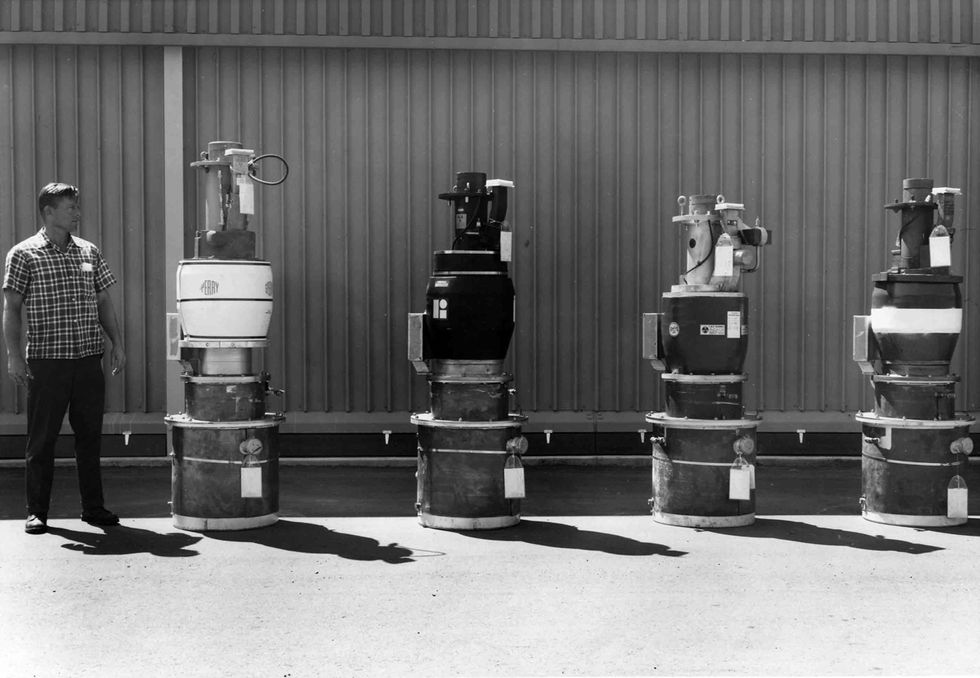
The klystron helped usher in the era of big science in high-energy physics. Klystrons convert the kinetic energy of an electron beam into radio-frequency energy. The device has much greater output power than does a traveling-wave tube or a magnetron. The brothers Russell and Sigurd Varian invented the klystron in the 1930s and, with others, founded Varian Associates to market it. These days, Varian's tube business lives on at Communications and Power Industries.
Inside a klystron, electrons emitted by a cathode accelerate toward an anode to form an electron beam. A magnetic field keeps the beam from expanding as it travels through an aperture in the anode to a beam collector. In between the anode and collector are hollow structures called cavity resonators. A high-frequency signal is applied to the resonator nearest the cathode, setting up an electromagnetic field inside the cavity. That field modulates the electron beam as it passes through the resonator, causing the speed of the electrons to vary and the electrons to bunch as they move toward the other cavity resonators downstream. Most of the electrons decelerate as they traverse the final resonator, which oscillates at high power. The result is an output signal that is much greater than the input signal.
In the 1960s, engineers developed a klystron to serve as the RF source for a new 3.2-kilometer linear particle accelerator being built at Stanford University. Operating at 2.856 gigahertz and using a 250-kilovolt electron beam, the SLAC klystron produced a peak power of 24 MW. More than 240 of them were needed to attain particle energies of up to 50 billion electron volts.
The SLAC klystrons paved the way for the widespread use of vacuum tubes as RF sources for advanced particle physics and X-ray light-source facilities. A 65-MW version of the SLAC klystron is still in production. Klystrons are also used for cargo screening, food sterilization, and radiation oncology.
Ring-Bar Traveling-Wave Tube
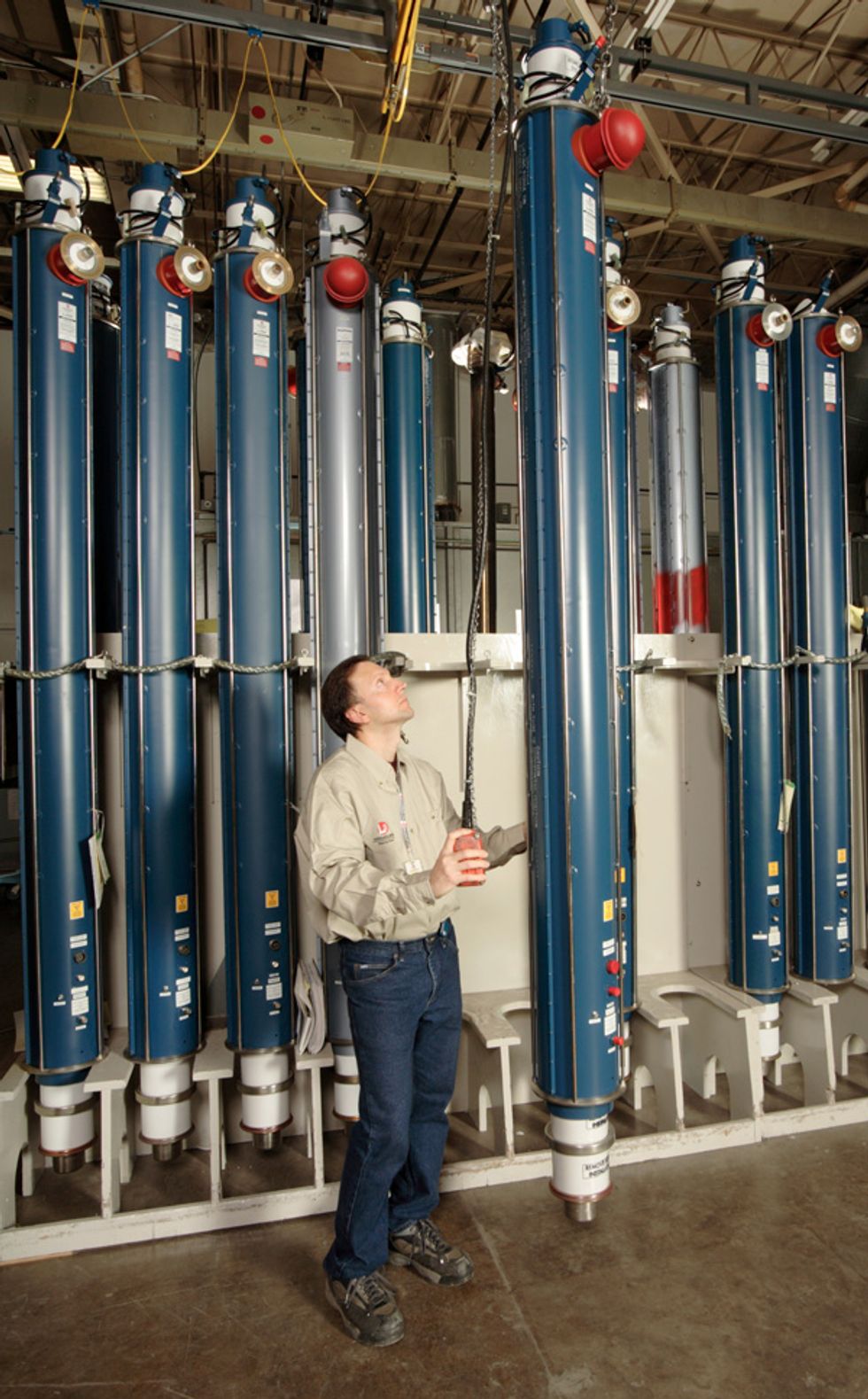
One Cold War tube that is still going strong is the huge ring-bar traveling-wave tube. This high-power tube stands over 3 meters from cathode to collector, making it the world's largest TWT. There are 128 ring-bar TWTs providing the radio-frequency oomph for an exceedingly powerful phased-array radar at the Cavalier Air Force Station in North Dakota. Called the Perimeter Acquisition Radar Attack Characterization System (PARCS), this 440-megahertz radar looks for ballistic missiles launched toward North America. It also monitors space launches and orbiting objects as part of the Space Surveillance Network. Built by GE in 1972, PARCS tracks more than half of all Earth-orbiting objects, and it's said to be able to identify a basketball-size object at a range of 2,000 miles (3,218 km).
An even higher-frequency version of the ring-bar tube is used in a phased-array radar on remote Shemya Island, about 1,900 km off the coast of Alaska. Known as Cobra Dane, the radar monitors non-U.S. ballistic missile launches. It also collects surveillance data on space launches and satellites in low Earth orbit.
The circuit used in this behemoth is known as a ring bar, which consists of circular rings connected by alternating strips, or bars, repeated along its length. This setup provides a higher field intensity across the tube's electron beam than does a garden-variety TWT, in which the radio-frequency waves propagate along a helix-shaped wire. The ring-bar tube's higher field intensity results in higher power gain and good efficiency. The tube shown here was developed by Raytheon in the early 1970s; it is now manufactured by L3Harris Electron Devices.
Ubitron
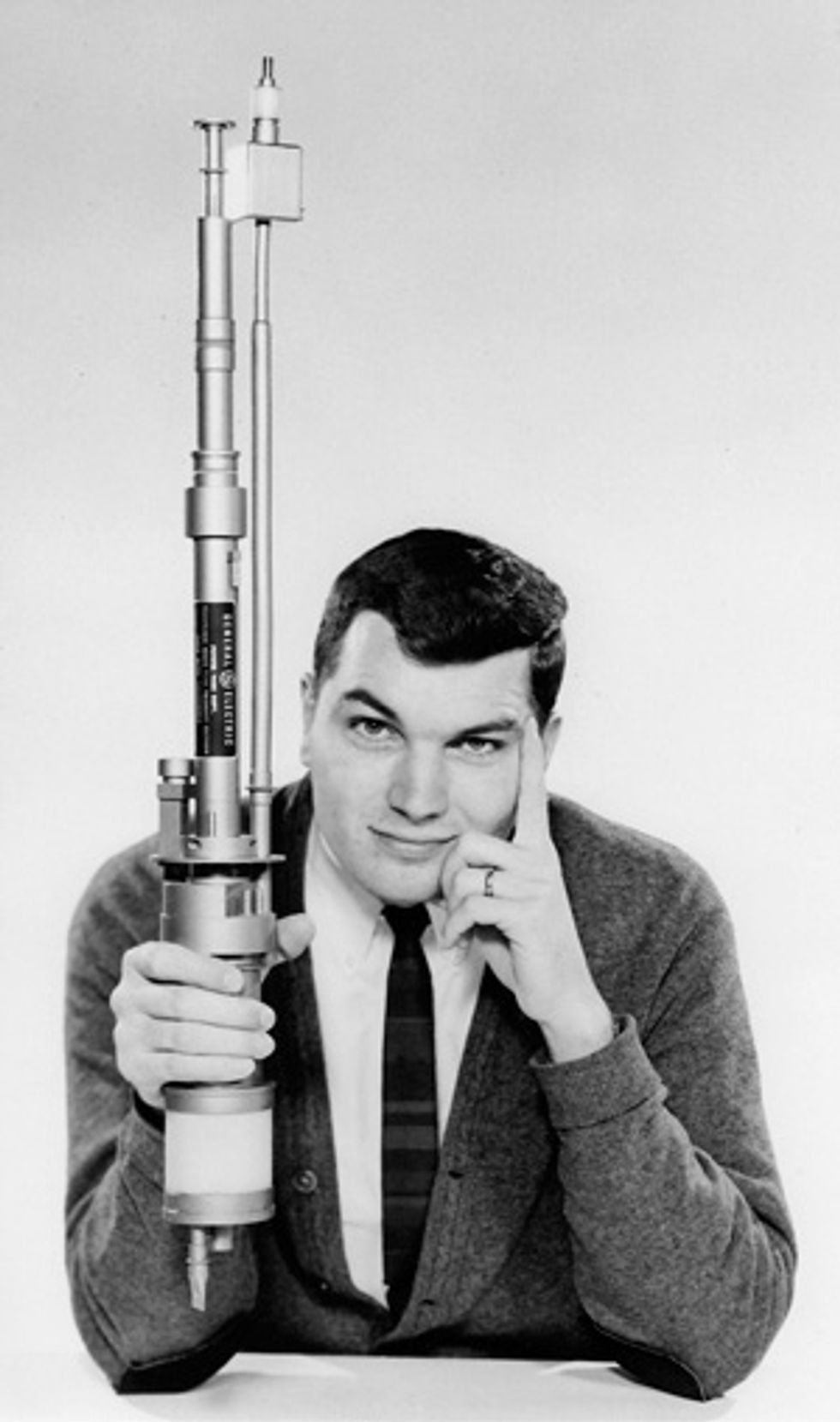
Fifteen years before the term “free-electron laser" was coined, there was a vacuum tube that worked on the same basic principle—the ubitron, which sort of stands for “undulating beam interaction."
The 1957 invention of the ubitron came about by accident. Robert Phillips, an engineer at the General Electric Microwave Lab in Palo Alto, Calif., was trying to explain why one of the lab's traveling-wave tubes oscillated and another didn't. Comparing the two tubes, he noticed variations in their magnetic focusing, which caused the beam in one tube to wiggle. He figured that this undulation could result in a periodic interaction with an electromagnetic wave in a waveguide. That, in turn, could be useful for creating exceedingly high levels of peak radio-frequency power. Thus, the ubitron was born.
From 1957 to 1964, Phillips and colleagues built and tested a variety of ubitrons. The 1963 photo shown here is of GE colleague Charles Enderby holding a ubitron without its wiggler magnet. Operating at 70,000 volts, this tube produced a peak power of 150 kW at 54 GHz, a record power level that stood for well over a decade. But the U.S. Army, which funded the ubitron work, halted R&D in 1964 because there were no antennas or waveguides that could handle power levels that high.
Today's free-electron lasers employ the same basic principle as the ubitron. In fact, in recognition of his pioneering work on the ubitron, Phillips received the Free-Electron Laser Prize in 1992. The FELs now installed in the large light and X-ray sources at particle accelerators produce powerful electromagnetic radiation, which is used to explore the dynamics of chemical bonds, to understand photosynthesis, to analyze how drugs bind with targets, and even to create warm, dense matter to study how gas planets form.
Carcinotron
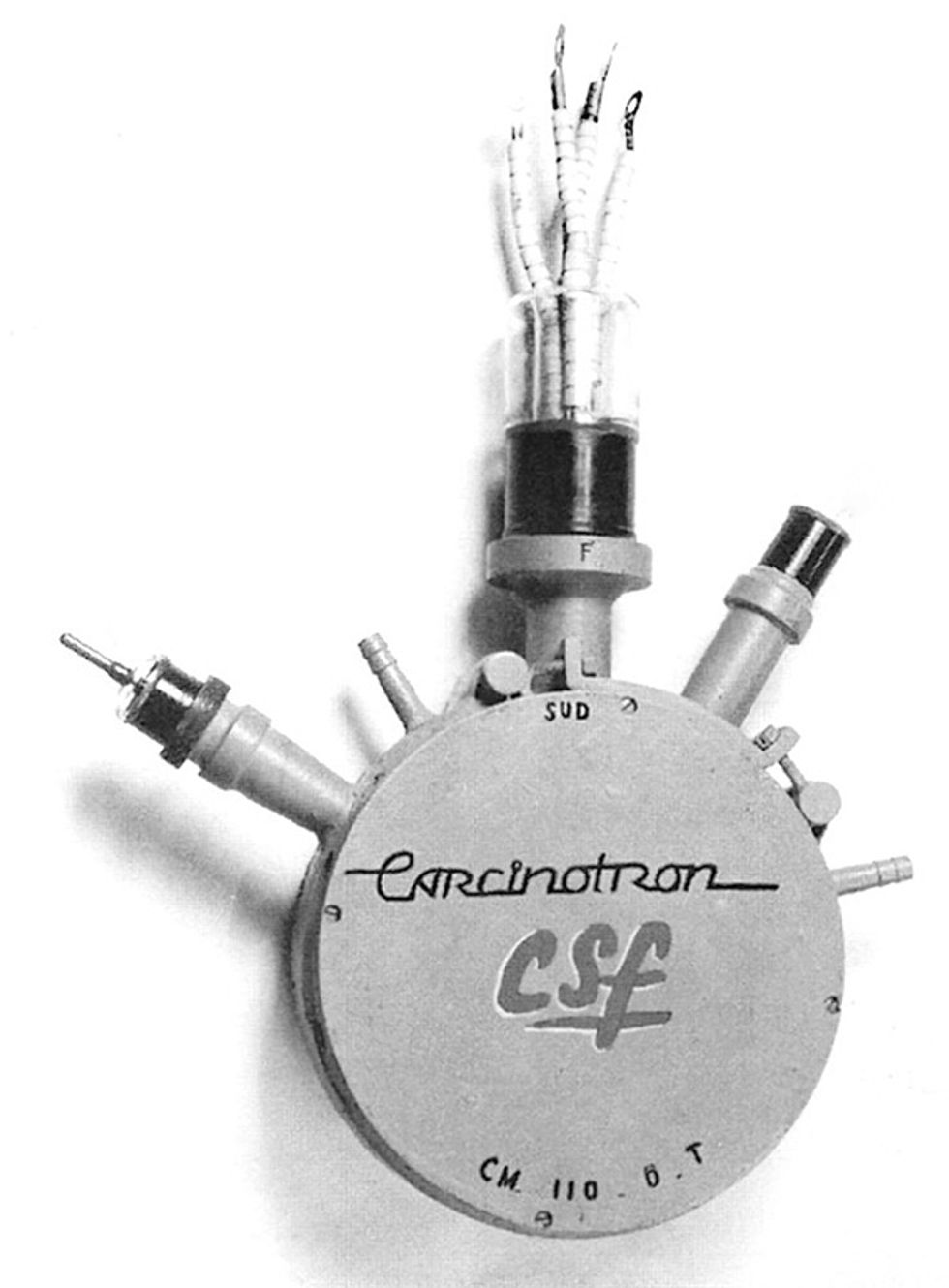
The French tube called the carcinotron is another fascinating example born of the Cold War. Related to the magnetron, it was conceived by Bernard Epsztein in 1951 at Compagnie Générale de Télégraphie Sans Fil (CSF, now part of Thales).
Like the ubitron, the carcinotron grew out of an attempt to resolve an oscillation problem on a conventional tube. In this case, the source of the oscillation was traced to a radio-frequency circuit's power flowing backward, in the opposite direction of the tube's electron beam. Epsztein discovered that the oscillation frequency could be varied with voltage, which led to a patent for a voltage-tunable “backward wave" tube.
For about 20 years, electronic jammers in the United States and Europe employed carcinotrons as their source of RF power. The tube shown here was one of the first manufactured by CSF in 1952. It delivered 200 W of RF power in the S band, which extends from 2 to 4 GHz.
Considering the level of power they can handle, carcinotrons are fairly compact. Including its permanent focusing magnet, a 500-W model weighs just 8 kg and measures 24 by 17 by 15 cm, a shade smaller than a shoebox.
And the strange name? Philippe Thouvenin, a vacuum electronics scientist at Thales Electron Devices, told me that it comes from a Greek word, karkunos, which means crayfish. And crayfish, of course, swim backwards.
Dual-Mode Traveling-Wave Tube
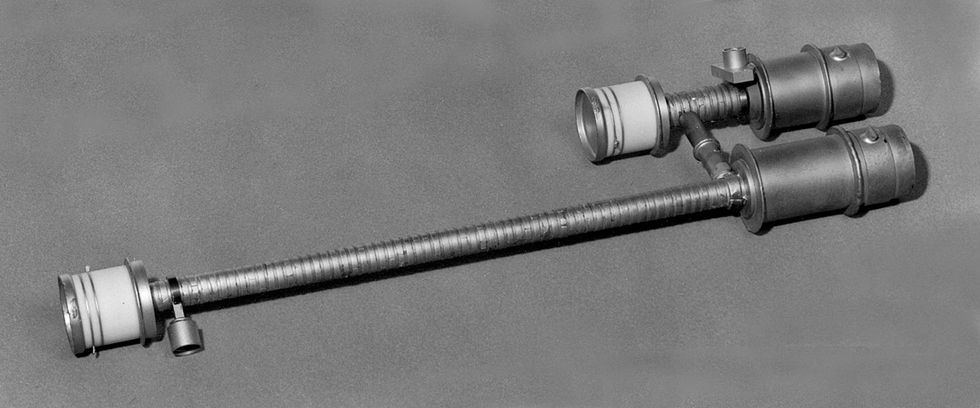
The dual-mode TWT was an oddball microwave tube developed in the United States in the 1970s and '80s for electronic countermeasures against radar. Capable of both low-power continuous-wave and high-power pulsed operation, this tube followed the old adage that two is better than one: It had two beams, two circuits, two electron guns, two focusing magnets, and two collectors, all enclosed in a single vacuum envelope.
The tube's main selling point was that it broadened the uses of a given application—a countermeasure system, for example, could operate in both continuous-wave and pulsed-power modes but with a single transmitter and a simple antenna feed. A control grid in the electron gun in the shorter, pulsed-power section could quickly switch the tube from pulsed to continuous wave, or vice versa. Talk about packing a lot of capability into a small package. Of course, if the vacuum leaked, you'd lose both tube functions.
The tube shown here was developed by Raytheon's Power Tube Division, which was acquired by Litton Electron Devices in 1993. Raytheon/Litton as well as Northrop Grumman manufactured the dual-mode TWT, but it was notoriously hard to produce in volume and was discontinued in the early 2000s.
Multi-Beam Klystron
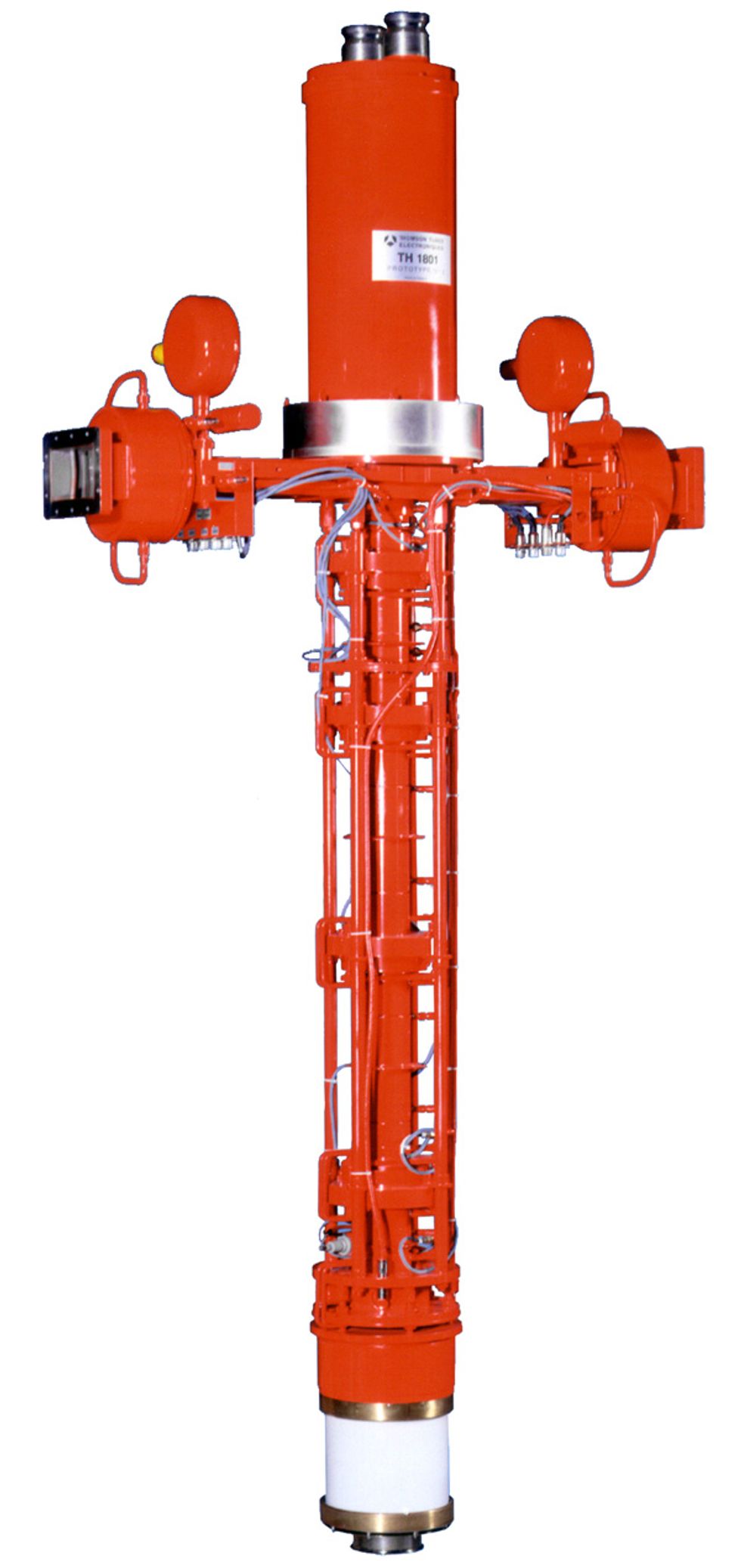
Power, as many of us learned as youngsters, equals voltage times current. To get more power out of a vacuum tube, you can increase the voltage of the tube's electron beam, but that calls for a bigger tube and a more complex power supply. Or you can raise the beam's current, but that can be problematic too. For that, you need to ensure the device can support the higher current and that the required magnetic field can transport the electron beam safely through the tube's circuit—that is, the part of the tube that interacts with the electron beam.
Adding to the challenge, a tube's efficiency generally falls as the beam's current rises because the bunching of the electrons required for power conversion suffers.
All these caveats apply if you're talking about a conventional vacuum tube with a single electron beam and a single circuit. But what if you employ multiple beams, originating from multiple cathodes and traveling through a common circuit? Even if the individual beam currents are moderate, the total current will be high, while the device's overall efficiency is unaffected.
Such a multiple-beam device was studied in the 1960s in the United States, the Soviet Union, and elsewhere. The U.S. work petered out, but activity in the USSR continued, leading to the successful deployment of the multi-beam klystron, or MBK. The Soviets fielded many of these tubes for radar and other uses.
A modern example of an MBK is shown above, produced in 2001 by the French firm Thomson Tubes Electroniques (now part of Thales). This MBK was developed for the German Electron Synchrotron facility (DESY). A later version is used at the European X-Ray Free Electron Laser facility. The tube has seven beams providing a total current of 137 amperes, with a peak power of 10 MW and average power of 150 kW; its efficiency is greater than 63 percent. By contrast, a single-beam klystron developed by Thomson provides 5 MW peak and 100 kW average power, with an efficiency of 40 percent. So, in terms of its amplification capability, one MBK is equivalent to two conventional klystrons.
Coaxitron
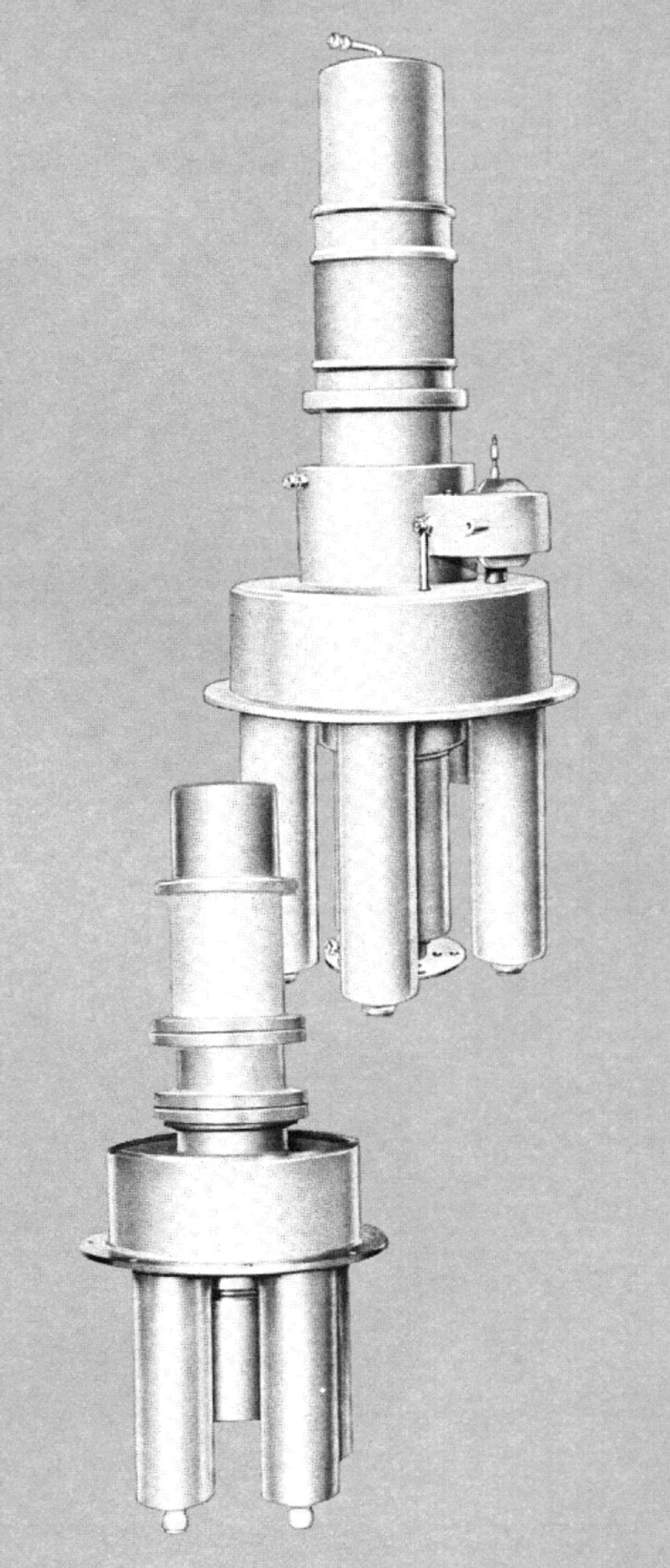
All the tubes I've described so far are what specialists call beam-wave devices (or stream-wave in the case of the magnetron). But before those devices came along, tubes had grids, which are transparent screenlike metal electrodes inserted between the tube's cathode and anode to control or modulate the flow of electrons. Depending on how many grids the tube has, it is called a diode (no grids), a triode (one grid), a tetrode (two grids), and so on. Low-power tubes were referred to as “receiving tubes," because they were typically used in radio receivers, or as switches. (Here I should note that what I've been referring to as a “tube" is known to the British as a “valve.")
There were, of course, higher-power grid tubes. Transmitting tubes were used in—you guessed it—radio transmitters. Later on, high-power grid tubes found their way into a wide array of interesting industrial, scientific, and military applications.
Triodes and higher-order grid tubes all included a cathode, a current-control grid, and an anode or collector (or plate). Most of these tubes were cylindrical, with a central cathode, usually a filament, surrounded by electrodes.
The coaxitron, developed by RCA beginning in the 1960s, is a unique permutation of the cylindrical design. The electrons flow radially from the cylindrical coaxial cathode to the anode. But rather than having a single electron emitter, the coaxitron's cathode is segmented along its circumference, with numerous heated filaments serving as the electron source. Each filament forms its own little beamlet of electrons. Because the beamlet flows radially to the anode, no magnetic field (or magnet) is required to confine the electrons. The coaxitron is thus very compact, considering its remarkable power level of around a megawatt.
A 1-MW, 425-MHz coaxitron weighed 130 pounds (59 kg) and stood 24 inches (61 cm) tall. While the gain was modest (10 to 15 dB), it was still a tour de force as a compact ultrahigh-frequency power booster. RCA envisioned the coaxitron as a source for driving RF accelerators, but it ultimately found a home in high-power UHF radar. Although coaxitrons were recently overtaken by solid-state devices, some are still in service in legacy radar systems.
Telefunken Audio Tube
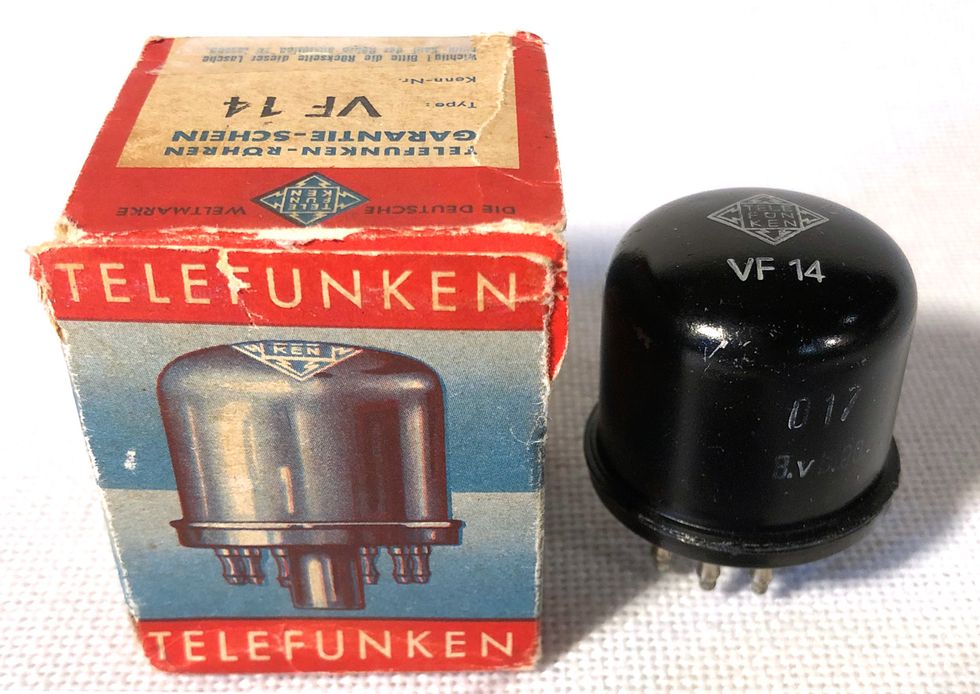
An important conventional tube with grids resides at the opposite end of the power/frequency spectrum from megawatt beasts like the klystron and the gyrotron. Revered by audio engineers and recording artists, the Telefunken VF14M was employed as an amplifier in the legendary Neumann U47 and U48 microphones favored by Frank Sinatra and by the Beatles' producer Sir George Martin. Fun fact: There's a Neumann U47 microphone on display at the Abbey Road Studio in London. The “M" in the VF14M tube designation indicates it's suitable for microphone use and was only awarded to tubes that passed screening at Neumann.
The VF14 is a pentode, meaning it has five electrodes, including three grids. When used in a microphone, however, it operates as a triode, with two of its grids strapped together and connected to the anode. This was done to exploit the supposedly superior sonic qualities of a triode. The VF14's heater circuit, which warms the cathode so that it emits electrons, runs at 55 V. That voltage was chosen so that two tubes could be wired in series across a 110-V main to reduce power-supply costs, which was important in postwar Germany.
Nowadays, you can buy a solid-state replacement for the VF14M that even simulates the tube's 55-V heater circuit. But can it replicate that warm, lovely tube sound? On that one, audio snobs will never agree.
This article appears in the November 2020 print issue as “The 9 Greatest Vacuum Tubes You've Never Heard Of."
Life of a Tube Guy

“If you'd told me I'd spend my career working on vacuum tubes, I'd have said, 'No way. That's crazy!' "
So says Carter M. Armstrong, who has in fact spent the last 40-some years working on vacuum devices. It started in graduate school, when his Ph.D. advisor at the University of Maryland turned him on to electron beams. And it continued through stints at North Carolina State University, the Naval Research Laboratory, Northrop Grumman, Litton, and most recently L3Harris, in Torrance, Calif., where he is director of advanced development for the company's Electron Devices division.
Throughout, Armstrong says, the work has been intellectually stimulating and emotionally rewarding. “It's good to work on hard problems," he says. “The physics is hard, the engineering is hard, and it's all interrelated. Not everybody can do this kind of work, but it gets in your blood, it really does."
In this photo, Armstrong, an IEEE Fellow, holds two of the devices he helped develop: a millimeter-wave mini traveling-wave tube and a microwave power module. Beyond the ubiquitous magnetrons in microwave ovens and the traveling-wave tubes in communications satellites, he says, vacuum devices still find their way into a surprisingly broad array of applications where “you need high efficiency, high power, and wide amplification bandwidth." Those applications include cancer therapy, fusion reactors, industrial heating, particle accelerators, radar, missile defense, and electronic warfare.
Almost all of the tubes in Armstrong's article are ones he helped design or came across during his career, but he included one based on the recommendation of his son Derek, a musician. That's the Telefunken VF14M, a specialized audio tube used in the much-revered Neumann U47 and U48 microphones. Over the decades, many recording artists have favored those mics, including Ella Fitzgerald, Frank Sinatra, and the Beatles.
“I'm a huge Beatles fan, so I was more than happy to include that one," Armstrong says.


